Kopnin N.B. Theory of Nonequilibrium Superconductivity
Подождите немного. Документ загружается.

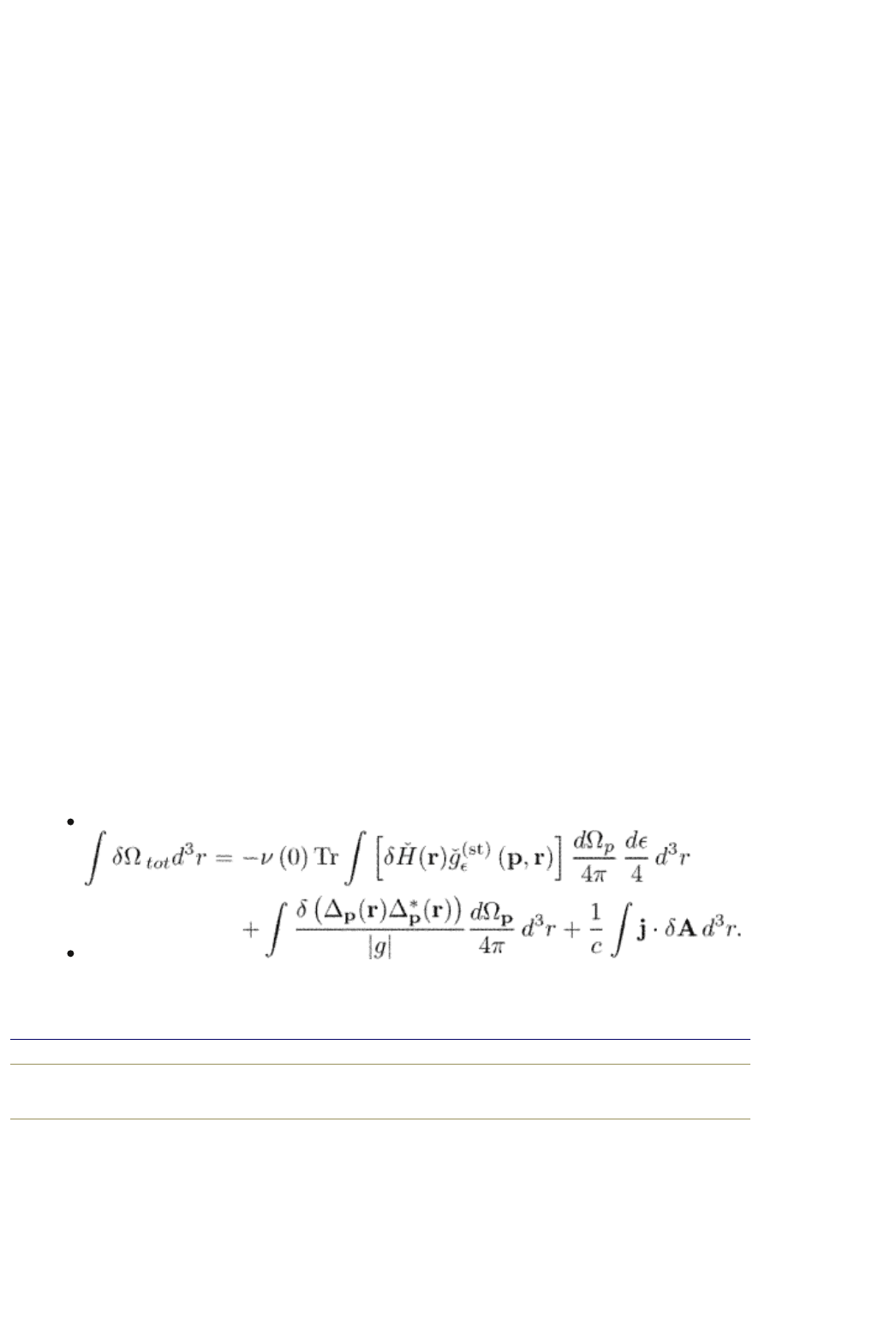
what is predicted by the conventional TDGL model. The flux-flow conductivity is
discussed as a function of temperature and the kinetic parameters.
Keywords: dirty superconductor, force, vortex, environment, Green
function, kinetic equation, flux-flow conductivity
The force exerted on a vortex from the environment is derived
microscopically. The kinetic equation is solved for the distribution function
of excitations driven out of equilibrium by the moving vortex; the flux flow
conductivity in a dirty superconductor is calculated. The vortex viscosity
appears to be much larger than what is predicted by the TDGL model.
13.1. Microscopic derivation of the force on moving vortices
The TDGL scheme can only be applied in very special situations under rather
restricting conditions of gapless superconductivity. This chapter treats the vortex
dynamics in a more general case when nonstationary processes in a
superconductor go beyond the TDGL model. We shall see that kinetics of
nonequilibrium excitations makes the nonstationary behavior of a superconductor
more complicated and diverse.
The complexity of the problem gives rise to the expectation that it would not be
easy to calculate anything beyond the simple TDGL equations. Fortunately, this is
not exactly the case, especially when we are interested in a linear response of a
vortex array to applied perturbations. The major simplification is that the force
on the moving vortex can be expressed through the characteristics of a static
vortex and through the solutions to the kinetic equations which only contain the
order parameter and magnetic field for a steady vortex array. The force thus
does not contain distortions of the order parameter and of the magnetic field
caused by the moving vortex. Restricting ourselves to the linear approximation in
the vortex velocity we start with the derivation of the general expression for the
force which acts on a moving vortex from the environment.
13.1.1 Variation of the thermodynamic potential
Let us consider a variation of the thermodynamic potential eqn (3.71) derived in
Section 3.3. We have in the real frequency representation
(13.1)
Here
end p.259
PRINTED FROM OXFORD SCHOLARSHIP ONLINE (www.oxfordscholarship.com)
© Copyright Oxford University Press, 2003-2010. All Rights Reserved
Oxford Scholarship Online: Theory of Nonequilibrium Supe... http://www.oxfordscholarship.com/oso/private/content/phy...
第4页 共6页 2010-8-8 16:04
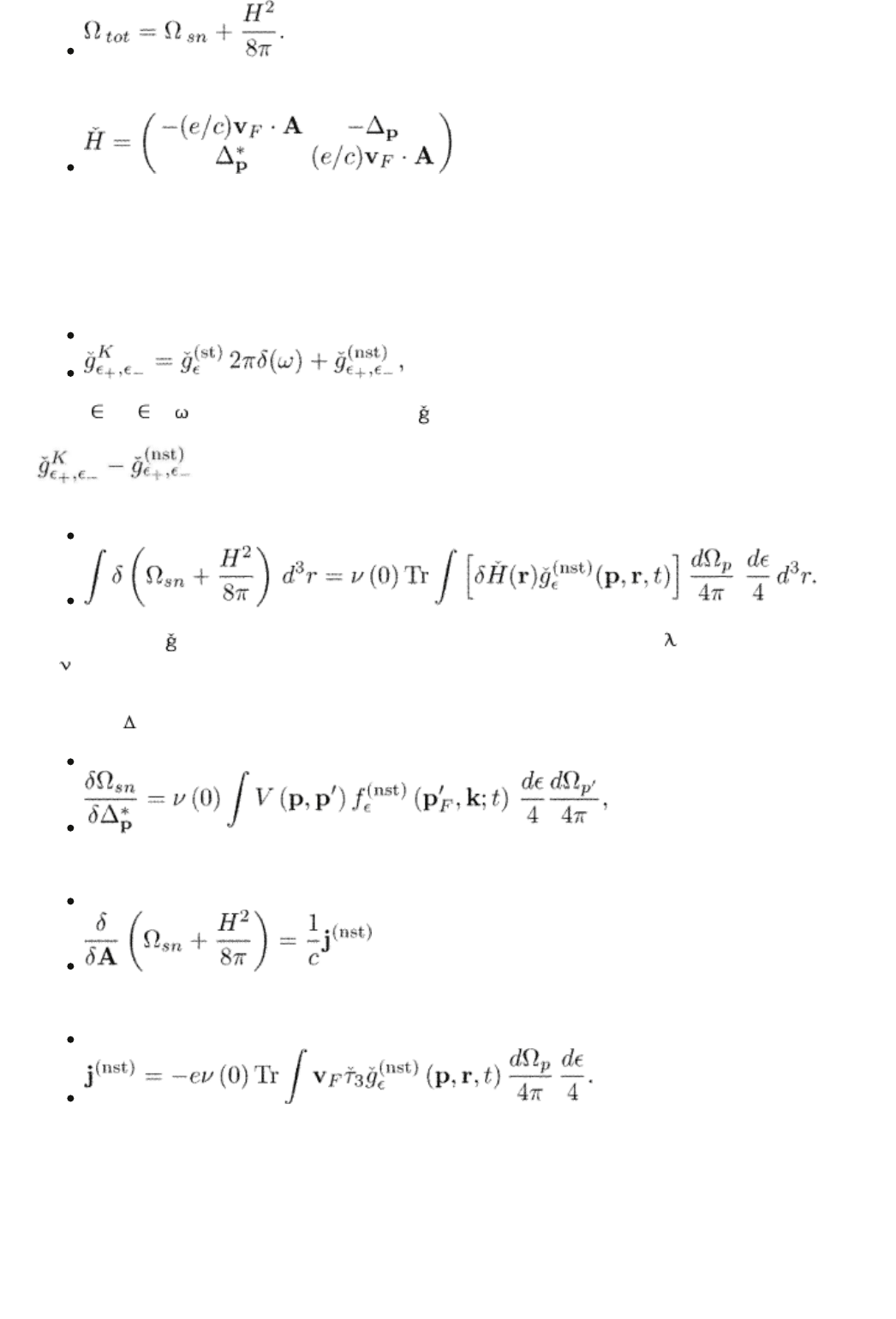
The Hamiltonian is
in the quasiclassical approximation. The variation eqn (13.1) is taken at a
constant chemical potential.
When the system is in a nonstationary state, the concept of thermodynamic
potential can be used only if deviations from the equilibrium are small. The total
Green function describing the nonstationary state in frequency representation is
(13.2)
where
±
= ± /2. It is the stationary part
(st)
which enters the variation of
the thermodynamic potential in eqn (13.1). We substitute it with the difference
, and take into account that the order parameter and the
current in the nonstationary state satisfy equations (9.17) and (9.18). We obtain
(13.3)
The terms with
K
disappear due to eqns (9.17) and (9.18) (we recall that =
|g| (0)).
Equation (13.3) determines the variation of the thermodynamic potential with
respect to and A. For example,
(13.4)
and
(13.5)
where
(13.6)
Equations (13.4) and (13.5) are microscopic counterparts of the corresponding
TDGL equations. The right-hand sides of these equations are proportional to
deviations from equilibrium; they vanish in a stationary state.
13.1.2 Force on vortices
Consider a variation of the total thermodynamic potential in the form
Oxford Scholarship Online: Theory of Nonequilibrium Supe... http://www.oxfordscholarship.com/oso/private/content/phy...
第5页 共6页 2010-8-8 16:04

(13.7)
end p.260
Top
Privacy Policy and Legal Notice © Oxford University Press, 2003-2010. All rights reserved.
Oxford Scholarship Online: Theory of Nonequilibrium Supe... http://www.oxfordscholarship.com/oso/private/content/phy...
第6页 共6页 2010-8-8 16:04
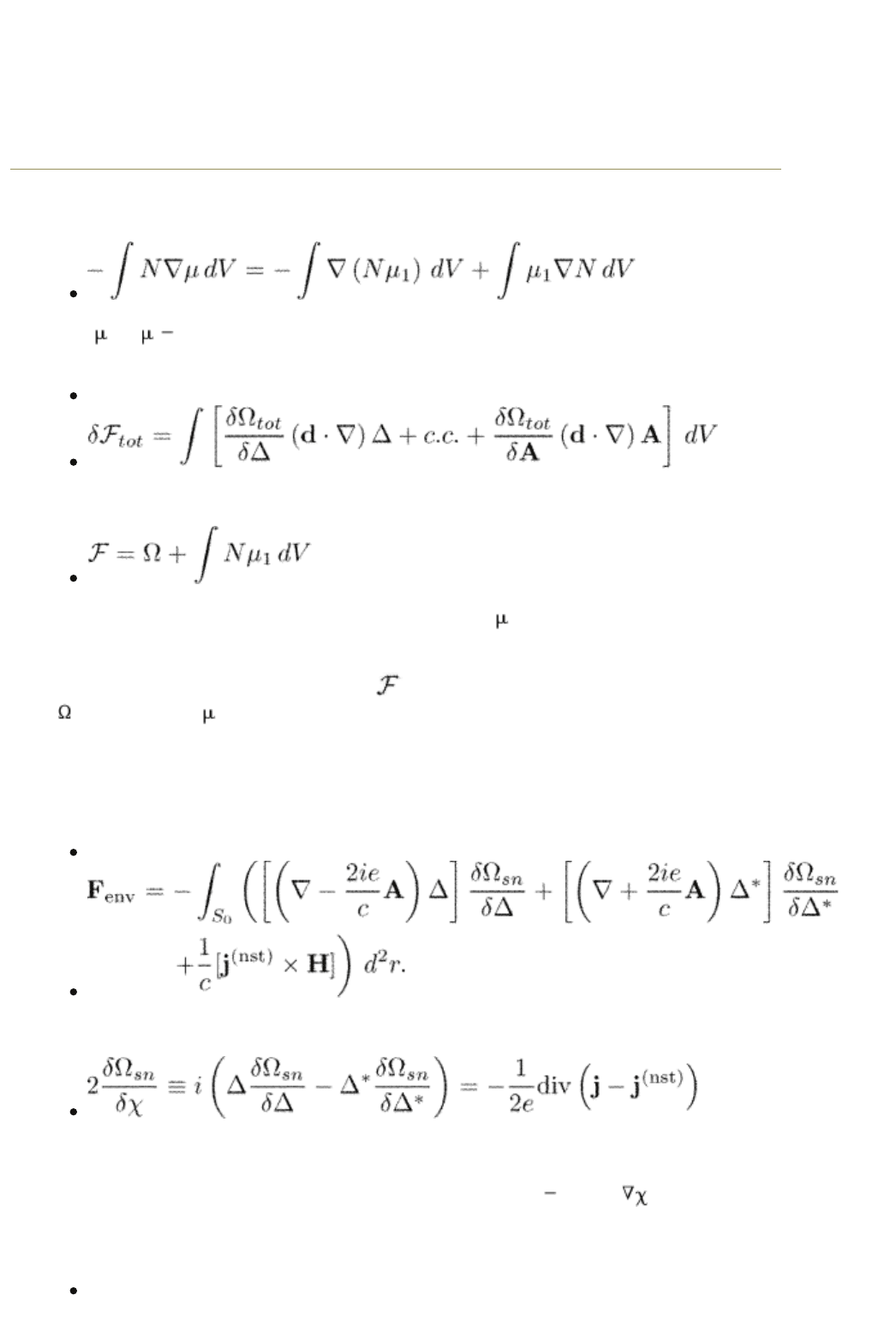
where d is an arbitrary constant vector of an infinitesimal translation. The last
term can be written as
where
1
= E
F
is the deviation of the chemical potential from its value in the
normal state. Equation (13.7) takes the form
(13.8)
where
is the free energy which is a function of N instead of . The gradient of the
particle density is omitted because the density is constant due to the charge
neutrality. Equation (13.8) follows from the general property of thermodynamic
functions: Variation of the free energy
for constant N is equal to the variation
of
for a constant . The gradient of free energy density for a constant number
of particles gives the density of force acting on the vortex from environment.
The r.h.s. of eqn (13.8) can be transformed in exactly the same way as we did it
earlier for the derivation of the force balance within the TDGL model in Section
12.4. The force from environment per unit vortex length becomes
(13.9)
The relation
used during the derivation follows from eqn (13.5) and the requirement of the
gauge invariance according to which the vector potential and the gradient of the
order parameter phase always come in the combination A
(c/2e) .
Using eqns (13.4) and (13.6) we can finally present eqn (13.9) in the form
(Larkin and Ovchinnikov 1986)
(13.10)
Kopnin, Nikolai, Senior Scientist, Low Temperature Laboratory, Helsinki University of
Technology, and L.D. Landau Institute for Theoretical Physics, Moscow
Theory of Nonequilibrium Superconductivity
Print ISBN 9780198507888, 2001
pp. [261]-[265]
Oxford Scholarship Online: Theory of Nonequilibrium Supe... http://www.oxfordscholarship.com/oso/private/content/phy...
第1页 共6页 2010-8-8 16:05
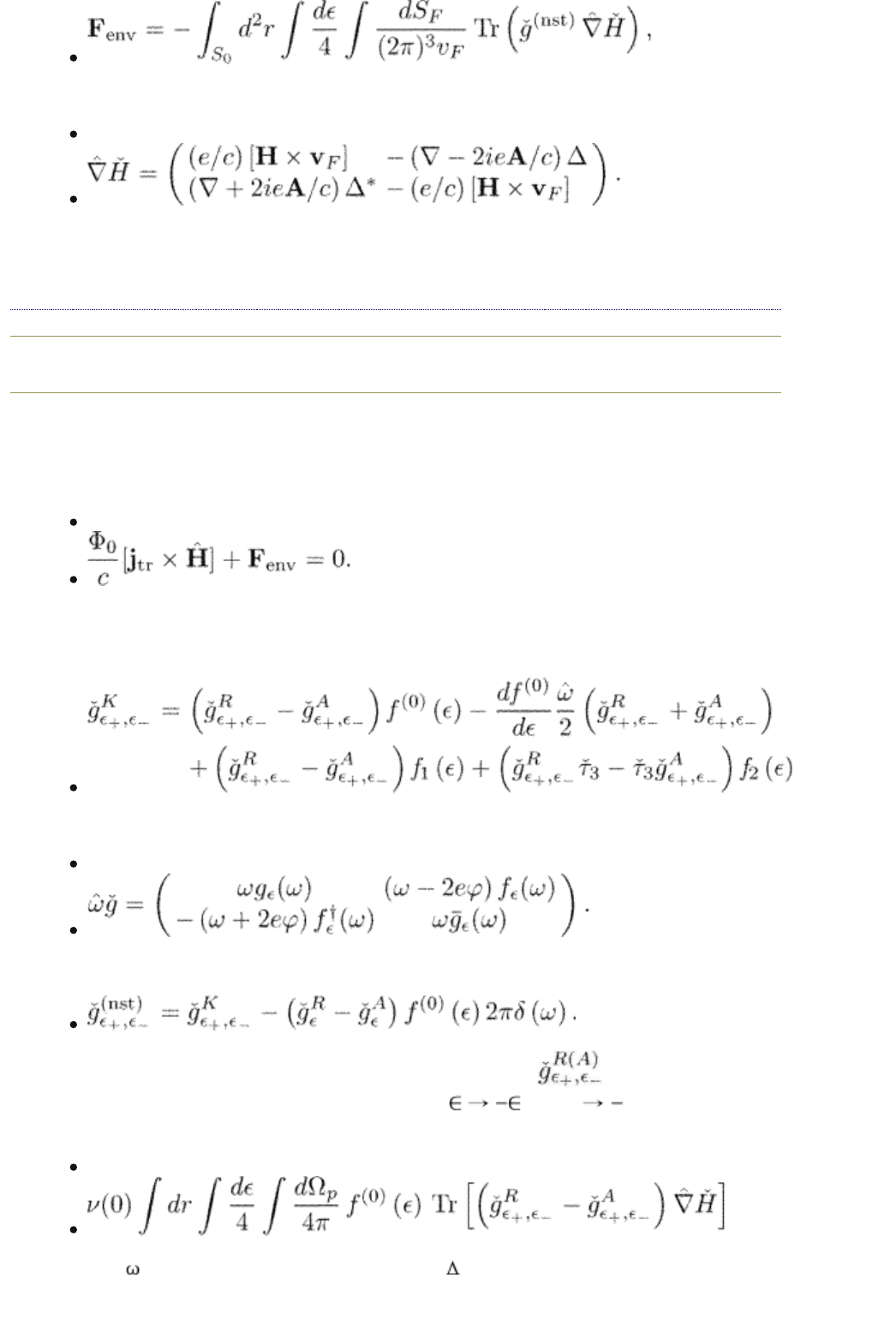
where
(13.11)
Equation (13.10) is written in the form which does not assume a spherical Fermi
surface.
end p.261
In presence of a transport current, the force F
env
should be balanced by the
Lorentz force. The corresponding term eqn (12.14) can be incorporated into the
free energy exactly in the same way as we did it in Section 12.4. The force
balance becomes
(13.12)
Consider now the nonstationary part of the Green function. We write the Keldysh
function eqn (10.62) in frequency representation
where
(13.13)
As in eqn (11.21) we define the nonstationary function as
Using the particle–hole symmetry of the Green functions of the type of
eqn (10.68) with respect to the transformation
and p p one can
show that
(13.14)
is even in . Therefore, the first derivatives of and A in time drop out of eqn
(13.14). As a result, the nonequilibrium part of the total Green function in eqn
PRINTED FROM OXFORD SCHOLARSHIP ONLINE (www.oxfordscholarship.com)
© Copyright Oxford University Press, 2003-2010. All Rights Reserved
Oxford Scholarship Online: Theory of Nonequilibrium Supe... http://www.oxfordscholarship.com/oso/private/content/phy...
第2页 共6页 2010-8-8 16:05
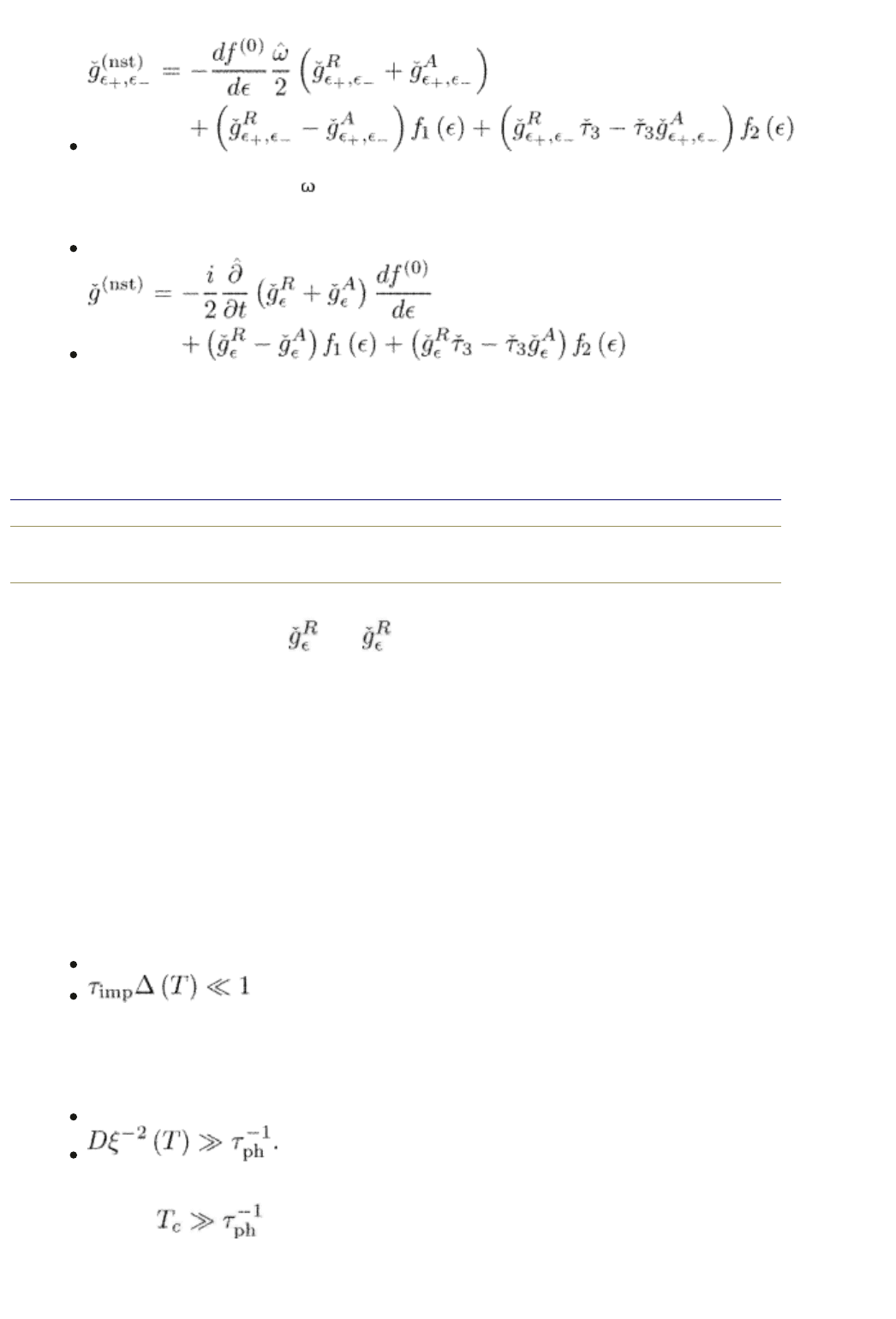
(13.10) can be written as
within the first-order terms in . Performing the Fourier transformation back to
the center-of-mass time, we get
(13.15)
where the gauge-invariant time-derivative is defined by eqn (10.32).
Equations (13.10) and (13.15) make the basis for calculations of the force on a
vortex within the microscopic theory. We shall use them for both dirty and clean
end p.262
superconductors in the following sections. We observe that the force is expressed
through the Green functions
and , as well as through the distribution
functions f
1
and f
2
. For the Green functions we can take their values for a steady
vortex array because f
1
and f
2
are themselves proportional to deviation from
equilibrium. In turn, f
1
and f
2
are solutions of kinetic equations which again
contain only the steady-state Green functions. The problem thus reduces to two
major steps. First, we need to find the Green functions for a stationary vortex.
Second, we solve the resulting kinetic equations and find the distribution function
of nonequilibrium excitations. The force can then be calculated performing the
necessary operations in eqn (13.10).
13.2. Diffusion controlled flux flow
In this section we consider dirty s-wave superconductors such that
(13.16)
for temperatures close to T
c
. Note that the gradients are not assumed to be small
any more in the sense of eqn (11.9). On the contrary, we concentrate on the
situation when the relaxation by diffusion is faster than the inelastic relaxation:
(13.17)
We recall also that the inelastic relaxation rate is much smaller than the critical
temperature,
. The temperature range when the condition eqn
(13.17) is fulfilled corresponds to
PRINTED FROM OXFORD SCHOLARSHIP ONLINE (www.oxfordscholarship.com)
© Copyright Oxford University Press, 2003-2010. All Rights Reserved
Oxford Scholarship Online: Theory of Nonequilibrium Supe... http://www.oxfordscholarship.com/oso/private/content/phy...
第3页 共6页 2010-8-8 16:05
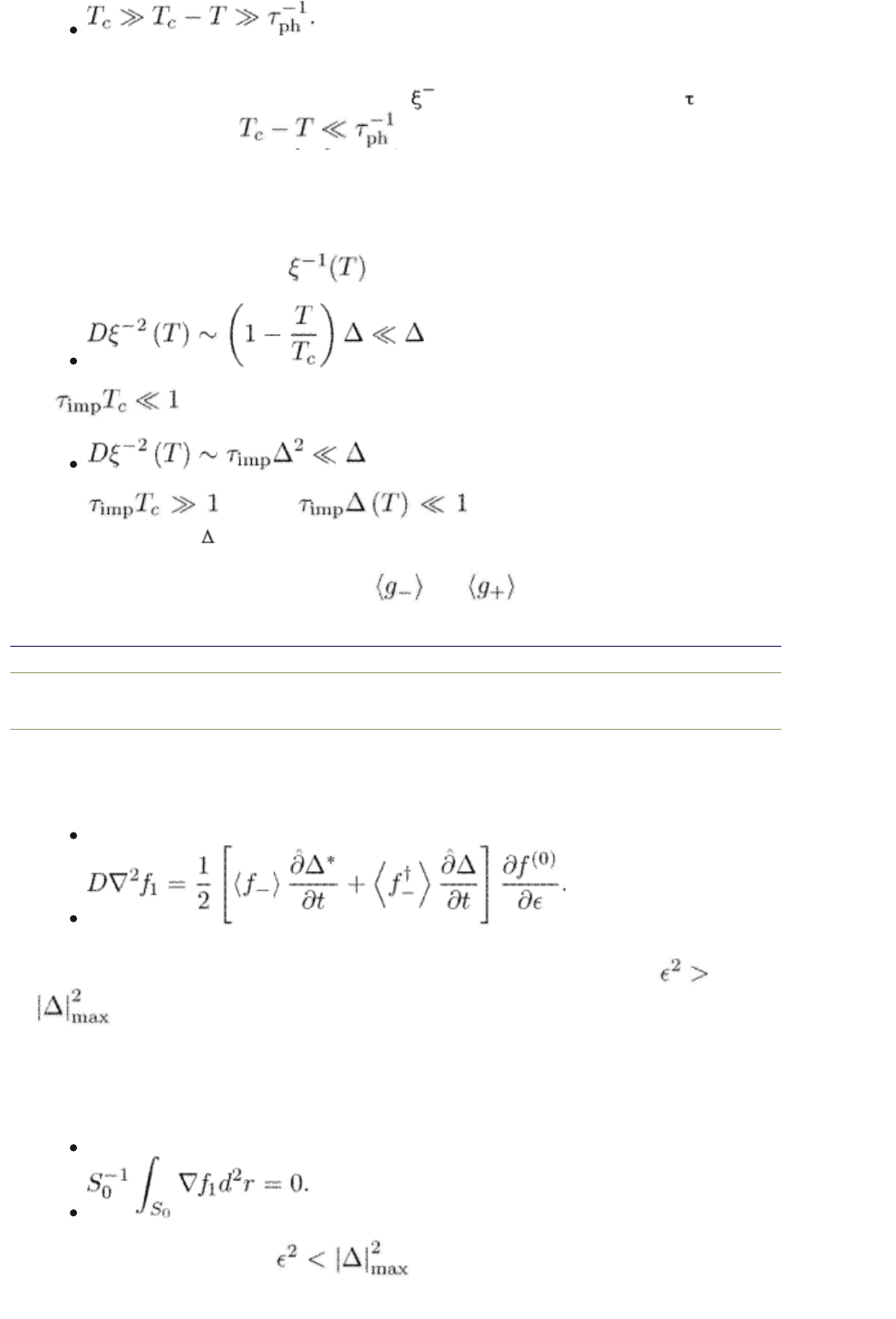
This condition is much less restrictive than what we have considered in the
previous chapter where, on the contrary, D
2
was assumed smaller than
ph
and thus temperatures were required. The present conditions
are more “natural” and can easily be realized in experiments.
Due to eqn (13.16) the stationary Green functions for dirty superconductors are
determined by Usadel equations (5.97). For temperatures close to T
c
, the
diffusion terms in the Usadel equations can be neglected despite the fact that the
gradients are of the order of
. Indeed,
if , or
when but still . The diffusion terms are thus
small compared to
under conditions of eqn (13.16). We also neglect the small
inelastic pair-breaking. As a result, we obtain the adiabatic expressions (10.104)
and (10.105) for the regular functions
and .
end p.263
Under these conditions, we can use kinetic equations (10.107) and (10.108)
derived for adiabatic Green functions. Neglecting the inelastic scattering we
obtain
(13.18)
The boundary conditions for eqn (13.18) are formulated as follows. For
, the quasiparticle Green functions extend over long distances from the
vortex cores. For a periodic vortex array, the distribution function f
1
is
translationally invariant with the period of the vortex array. Thus it should not
increase at large distances from the vortex. This requires that the average
gradient of f
1
vanishes
(13.19)
However, for particles with , large distances are not accessible.
The boundary conditions are imposed at the surface determined by the condition
PRINTED FROM OXFORD SCHOLARSHIP ONLINE (www.oxfordscholarship.com)
© Copyright Oxford University Press, 2003-2010. All Rights Reserved
Oxford Scholarship Online: Theory of Nonequilibrium Supe... http://www.oxfordscholarship.com/oso/private/content/phy...
第4页 共6页 2010-8-8 16:05
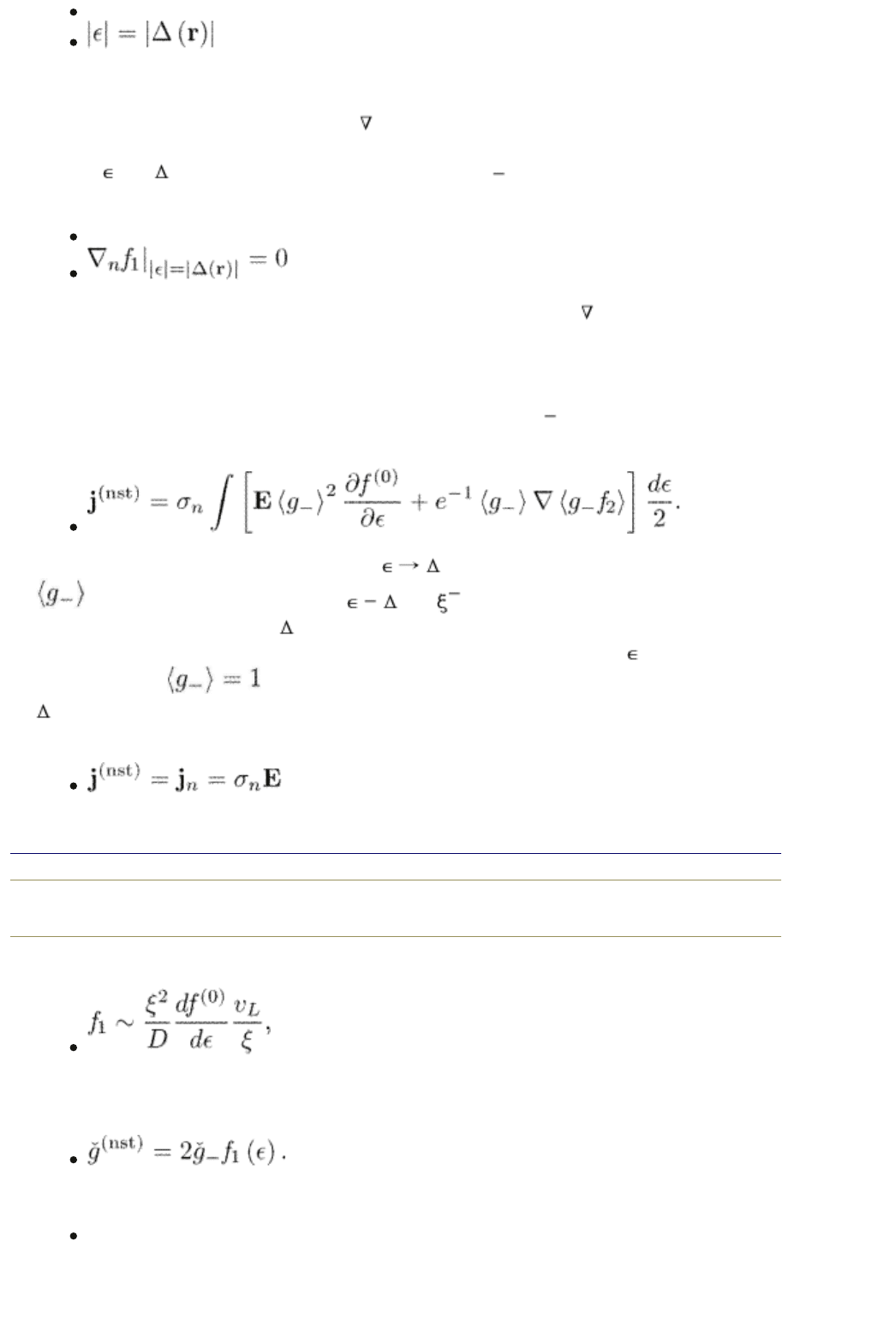
(13.20)
beyond which the particle cannot penetrate. The conditions can be obtained from
eqns (10.106) and (13.18). Integrating eqn (13.18) across the surface in eqn
(13.20) one finds that the derivative
n
f
1
along its normal is continuous at this
surface. At the same time, eqn (10.106) implies that, at the side of the surface
where |
| < | (r)|, the gradient vanishes because g = 0. Therefore, one should
also have
(13.21)
at the other side of the surface defined by eqn (13.20), where
n
is the
derivative along the normal to the surface. Equations (13.19) and (13.21) are
the required boundary conditions to eqn (13.18) (Larkin and Ovchinnikov 1986).
The expression for the force eqn (13.10) contains the nonstationary part of the
current eqn (13.6) proportional to the energy integral of g
f
1
. According to eqn
(10.108), we have
The integral diverges logarithmically at due to a square-root singularity in
. This divergence is cut off at ~ D
2
. However, the prefactor at the
logarithm is proportional to
/T; it is thus small near the critical temperature.
The main contribution, however, comes from the region of energies
~ T. For
such energies,
. At the same time, the function f
2
is proportional to
/T (compare with eqn (11.19)) and can be neglected. As a result, we again
have
end p.264
According to eqn (13.18), the distribution function is, by the order of magnitude,
and gives a much larger contribution to the nonstationary Green function than
the first term in the r.h.s. of eqn (13.15). Therefore, neglecting f
2
we have
Equation (13.10) becomes
(13.22)
PRINTED FROM OXFORD SCHOLARSHIP ONLINE (www.oxfordscholarship.com)
© Copyright Oxford University Press, 2003-2010. All Rights Reserved
Oxford Scholarship Online: Theory of Nonequilibrium Supe... http://www.oxfordscholarship.com/oso/private/content/phy...
第5页 共6页 2010-8-8 16:05
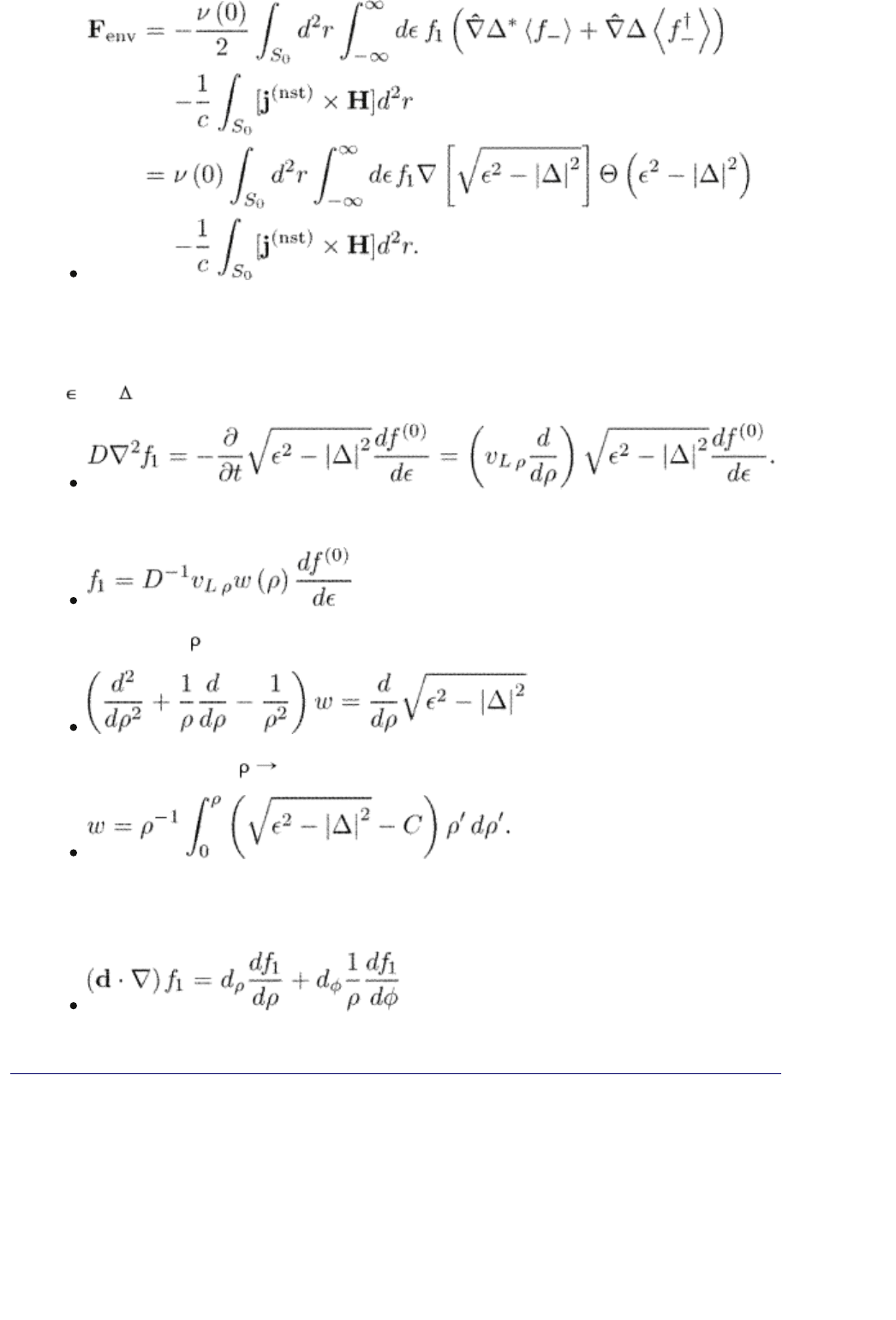
The next step is to solve the kinetic equation (13.18) for f
1
. Consider first the
limit of low magnetic fields. For well-separated vortices, the order parameter
magnitude depends only on the distance from the vortex axis. Equation (13.18)
for
2
> | |
2
takes the form
We put
and obtain for w ( )
The solution regular at 0 is
The constant should be found from the boundary conditions. Denote d a constant
arbitrary vector. We have
end p.265
Top
Privacy Policy and Legal Notice © Oxford University Press, 2003-2010. All rights reserved.
Oxford Scholarship Online: Theory of Nonequilibrium Supe... http://www.oxfordscholarship.com/oso/private/content/phy...
第6页 共6页 2010-8-8 16:05
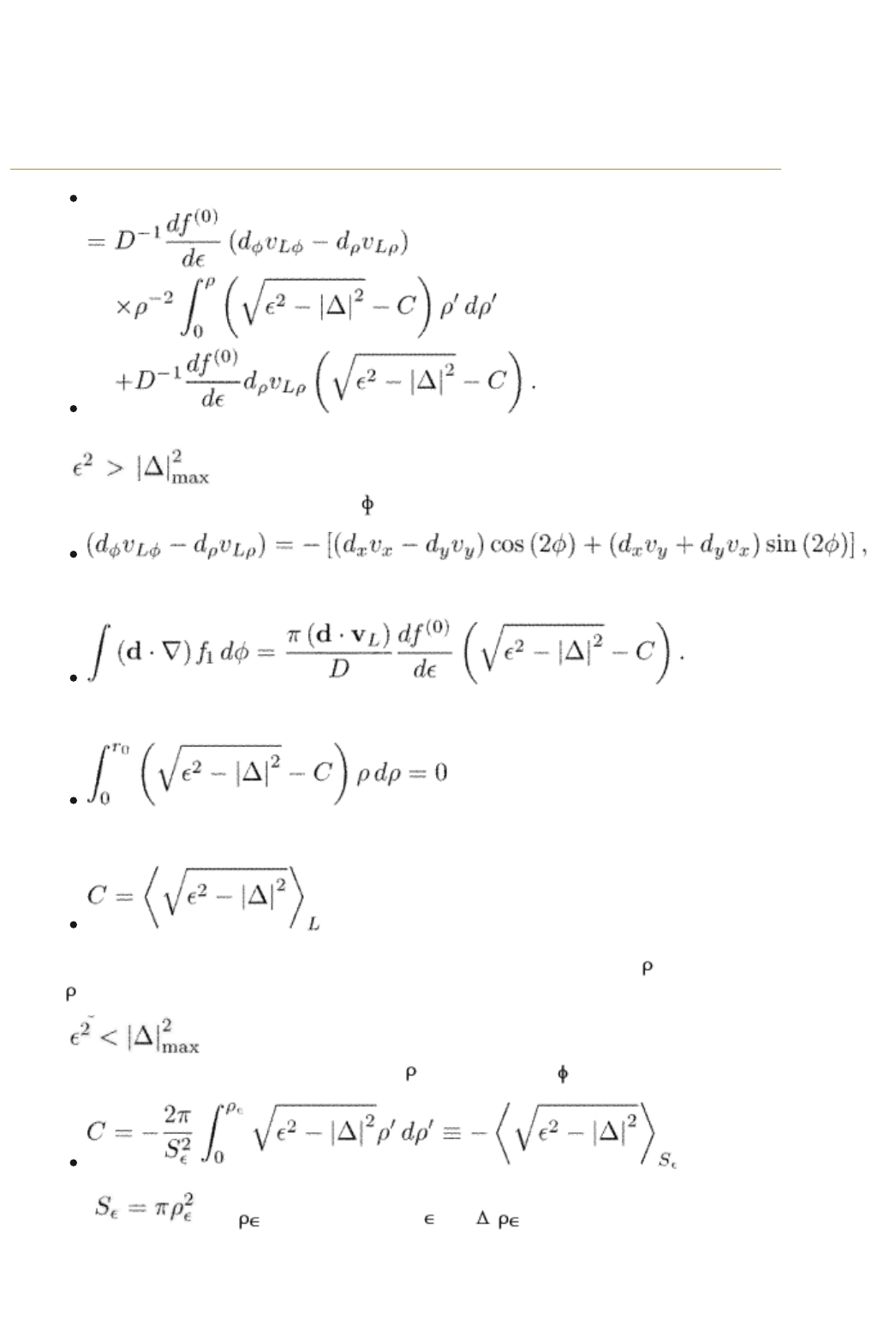
(13.23)
For , the boundary condition has the form of eqn (13.19). We
average eqn (13.23) over the angles
Since
the first term in the r.h.s. of eqn (13.23) vanishes. The second term gives
Integrating now over the radial distance, we have from eqn (13.19)
where r
0
is the radius of the vortex lattice unit cell. Thus
where the average is taken over the vortex unit cell. The function w ( ) vanishes
for
= r
0
.
For
, we use the boundary condition eqns (13.21). Equation
(13.23) taken for the derivative along the
direction with d = 0 gives
where and is determined by | | = | ( )|.
Now we calculate the force on a vortex. The balance of the Lorentz force and the
force in eqn (13.22) reads
Kopnin, Nikolai, Senior Scientist, Low Temperature Laboratory, Helsinki University of
Technology, and L.D. Landau Institute for Theoretical Physics, Moscow
Theory of Nonequilibrium Superconductivity
Print ISBN 9780198507888, 2001
pp. [266]-[270]
Oxford Scholarship Online: Theory of Nonequilibrium Supe... http://www.oxfordscholarship.com/oso/private/content/phy...
第1页 共6页 2010-8-8 16:06
